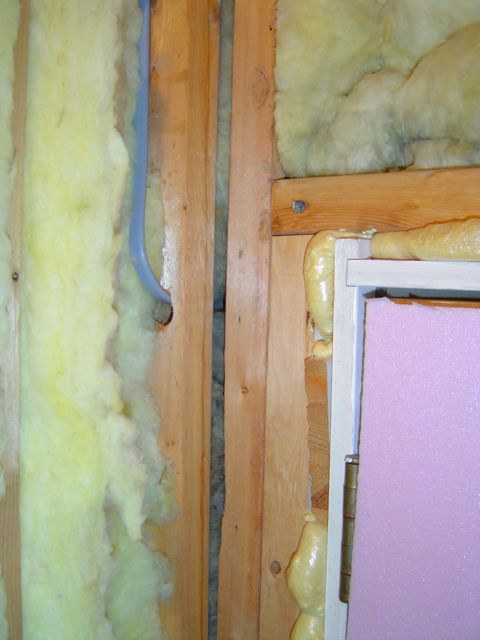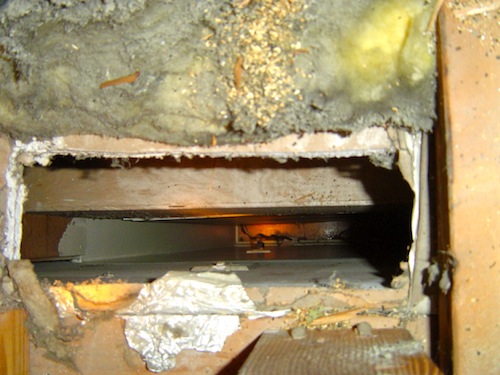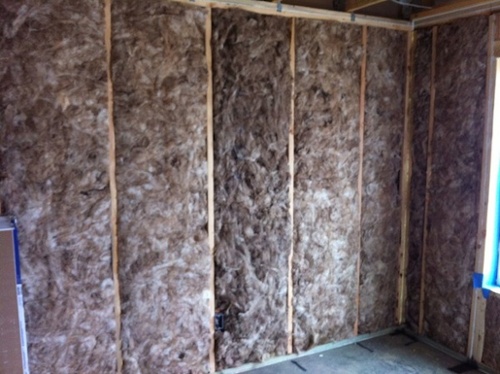Are You Confusing Insulation with Air Barriers?

I read a lot of stuff online about insulation and air barriers and other building science topics. I see a fair number of articles bashing certain products or materials. Sometimes it’s because the author sells a competing product. Sometimes they just don’t like a product. Take fiberglass insulation, for example. What thoughts just went through your head?
I read a lot of stuff online about insulation and air barriers and other building science topics. I see a fair number of articles bashing certain products or materials. Sometimes it’s because the author sells a competing product. Sometimes they just don’t like a product. Take fiberglass insulation, for example. What thoughts just went through your head?
Those who have some building science training will look at the photo above and immediately see the symptom of a problem. The places where that formerly yellow fiberglass insulation has turned dark grey are places where air is moving through the fiberglass.
Some people will jump from that symptom straight to a guilty verdict for fiberglass. Sometimes they’ll even derisively call it “filterglass” because it doesn’t stop the air from moving through it.
But is the type of insulation really the source of the problem here?
What about the photo below? It’s another case where the light-colored insulation has turned dark by picking up dirt from the air moving through it. Is the problem that they used an air permeable insulation material?

Or could it be that there’s a huge freakin’ hole in the ceiling!? Seal the hole and the fiberglass will perform a lot better. When you think in terms of building enclosure control layers, it’s a lot easier to assign the blame correctly.
A good building will have control layers that control the flows of heat, air, and moisture. Just because a failure in the air control layer (air barrier) shows up in the heat control layer (insulation) doesn’t mean it’s the fault of the insulation.
Hey, I’ve bashed fiberglass here in this blog. I wasn’t condemning it as a product, though; the way it often gets installed is what irked me. (I heard from one of the manufacturers about that article, but that’s a whole other story.)
But fiberglass and other air-permeable insulation can work just fine. It can be installed well, too. Here’s a perfect example of a Grade 1 installation I saw in Nashville a few years ago.

Everyone has their preferences, and that’s fine. But if you’re going to argue against a product, make sure you’re using valid arguments. Dirt showing in fiberglass insulation isn’t a valid reason to convict fiberglass.
Related Articles
Batts, Blown, or Sprayed – What’s the Best Attic Insulation?
The Pen Test — A Control Layers Tool for Architects and Contractors
The Diminishing Returns of Adding More Insulation
NOTE: Comments are moderated. Your comment will not appear below until approved.
This Post Has 9 Comments
Comments are closed.

Thanks, Allison. Most clients
Thanks, Allison. Most clients tell me initially that their houses are poorly insulated, when usually it’s an issue of air leakage. It’s fun to hear them quoting their blower door numbers at project completion… and to hear stories of how their house changed!
Yep. It’s perfectly normal
Yep. It’s perfectly normal for homeowners not to understand this, Nate, but contractors, designers, and home energy pros ought to know better.
I get involved in water
I get involved in water intrusion therefor mold, indoor air quality and occupants health issues. We can tighten the standards but the occupants who are living in these environments have to be educated before they become victims of their own doing. We can make the homes hospital clean but we are not educating the occupants on what is needed to maintain a health environment. It is not hard it is mainly common sense and some of the problems are not picked up by the medical or testing community since they are not experts in construction.
Allison: I am having a hard
Allison: I am having a hard time determining what I am looking at in your second photo. Can you tell me what I am looking at (a wall, a chase, a duct)? Thank you John
That’s the refrigerator vent,
That’s the refrigerator vent, John. Surely they do that out in California, right? ;~)
I took that photo in my in-laws’ home. I was crawling around the attic and saw a big black spot in the insulation. When I pulled it back, that’s the hole I saw. They’d had their kitchen redone a few years earlier and someone must have had the bright idea to cut a hole above the fridge to vent the heat from it into the attic. One of the stupidest holes I’ve ever seen.
For counterbalance, you
For counterbalance, you should include a photo of fiberglass done right, no?
Thanks, David. When I first
Thanks, David. When I first started writing the article, I had meant to do that but then forgot. I’ve added one now.
Thanks Allison, all good
Thanks Allison, all good points. Really enjoy your blog.
BTW, is there any way for you to use larger images in your articles such that they can be clicked and expanded? It’s very difficult to discern the details you mention when many of the photos are under 500px. Thanks again.
I looked at the home page of
I looked at the home page of the ‘un-named’ insulation manufacturer that sent you the threatening letter. I was looking for their installation instructions. (I could never locate them.) The very first picture you see on their page is batt insulation installed incorrectly.